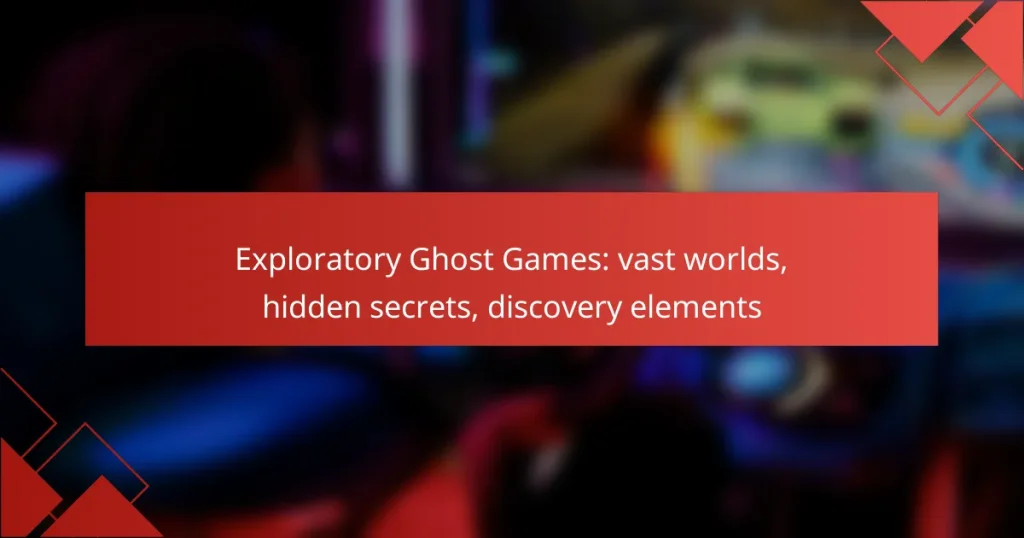Exploratory ghost games offer players an immersive experience within vast worlds teeming with hidden secrets and discovery elements. These games invite players to engage deeply with their environments, uncovering narratives and solving mysteries at their own pace while interacting with spectral entities. The thrill of exploration is heightened by the rewards of unique content and unlockable story elements, enriching the overall gameplay experience.

How do Exploratory Ghost Games enhance player experience?
Exploratory ghost games significantly enhance player experience by immersing them in vast worlds filled with hidden secrets and discovery elements. These games encourage exploration and interaction, allowing players to uncover narratives and solve mysteries at their own pace.
Immersive environments
Immersive environments in exploratory ghost games create a sense of presence that draws players into the game world. Detailed graphics, ambient sounds, and atmospheric effects contribute to a realistic experience, making players feel as if they are truly part of the setting.
For example, a haunted mansion might feature creaking floorboards, flickering lights, and ghostly whispers that enhance the eerie atmosphere. Players often find themselves exploring every corner, driven by curiosity and the desire to uncover hidden secrets.
Dynamic storytelling
Dynamic storytelling in these games allows players to influence the narrative through their choices and actions. Instead of a linear plot, players encounter branching storylines that adapt based on their discoveries and interactions with characters.
This approach encourages players to engage deeply with the story, as their decisions can lead to different outcomes. For instance, choosing to investigate a specific room might reveal crucial information that alters the course of the game.
Engaging puzzles
Engaging puzzles are a hallmark of exploratory ghost games, challenging players to think critically and creatively. These puzzles often require players to gather clues from the environment, combining observation and logic to solve them.
Common types of puzzles include deciphering codes, finding hidden objects, or completing tasks that unlock new areas. Players should be prepared to experiment and explore, as solutions may not always be straightforward.
Community interaction
Community interaction enhances the experience by allowing players to share discoveries, strategies, and theories. Many games feature forums or social media groups where players can discuss their findings and collaborate on solving complex puzzles.
Participating in these communities can provide valuable insights and tips, enriching the gameplay experience. Players should consider joining discussions to enhance their understanding and enjoyment of the game world.

What are the best Exploratory Ghost Games available?
The best exploratory ghost games combine immersive environments with elements of discovery and mystery. Players can engage in thrilling adventures while uncovering hidden secrets and interacting with spectral entities.
Phasmophobia
Phasmophobia is a cooperative multiplayer game where players take on the role of ghost hunters. Teams investigate haunted locations to identify the type of ghost present, using various tools like EMF readers and spirit boxes.
Success in Phasmophobia relies on communication and teamwork. Players must gather evidence while avoiding the ghost, which can become aggressive. The game features a variety of ghost types, each with unique behaviors, making each session unpredictable.
Ghost Hunters Corp
Ghost Hunters Corp offers a unique twist on the ghost-hunting genre by incorporating a business management aspect. Players form a ghost-hunting team and manage resources while exploring haunted sites to capture evidence of paranormal activity.
This game emphasizes strategy, as players must balance their budget and equipment upgrades with the risks of each investigation. The cooperative gameplay encourages collaboration, making it ideal for groups looking for a mix of exploration and management.
Spiritfarer
Spiritfarer is a cozy management game centered around the theme of guiding spirits to the afterlife. Players take on the role of Stella, a ferrymaster, who builds a boat to explore a beautiful world filled with islands and hidden secrets.
The game focuses on exploration and relationship-building with spirits, each with their own stories and quests. Players can gather resources, craft items, and upgrade their boat while uncovering the emotional narratives of the spirits they help.
Ghost of Tsushima
Ghost of Tsushima is an action-adventure game set in feudal Japan, where players explore a vast open world filled with stunning landscapes and historical elements. While not strictly a ghost game, it features supernatural elements and a rich narrative involving the spirit of the samurai.
Players can engage in stealth, combat, and exploration, discovering hidden shrines and secrets throughout Tsushima. The game emphasizes the importance of choice and consequence, allowing players to shape their journey through the beautifully crafted environment.

How do hidden secrets impact gameplay in Exploratory Ghost Games?
Hidden secrets significantly enhance gameplay in Exploratory Ghost Games by encouraging exploration and rewarding players with unique content. These secrets often lead to unlockable items, new areas, or story elements that deepen the gaming experience.
Unlockable content
Unlockable content in Exploratory Ghost Games often includes special items, costumes, or abilities that players can acquire by discovering hidden secrets. For example, finding a hidden artifact might unlock a new character or provide unique gameplay mechanics that alter how players approach challenges.
Players should pay attention to environmental clues and explore off-the-beaten-path locations to maximize their chances of uncovering this content. Engaging with the game world thoroughly can yield significant rewards that enhance the overall experience.
Enhanced replayability
Hidden secrets contribute to enhanced replayability by providing players with new objectives and challenges during subsequent playthroughs. Each discovery can change the way players interact with the game, encouraging them to try different strategies or explore alternative paths.
Games that feature multiple secrets often have varying outcomes based on what players find, making each session feel fresh. This encourages players to revisit the game, aiming to uncover all hidden elements and fully experience the narrative.
Player discovery
Player discovery is a core element of Exploratory Ghost Games, as finding hidden secrets fosters a sense of achievement and curiosity. The thrill of uncovering a secret can motivate players to explore every corner of the game world, enhancing their emotional connection to the narrative.
To maximize player discovery, developers often design intricate environments filled with clues and puzzles. Players should remain observant and experiment with different interactions to reveal these secrets, which can lead to unexpected surprises and enrich the gameplay experience.

What are the key elements of discovery in these games?
The key elements of discovery in exploratory ghost games include environmental storytelling, collectibles, and interactive NPCs. These features create immersive experiences that encourage players to uncover hidden secrets and engage deeply with the game world.
Environmental storytelling
Environmental storytelling refers to the way a game’s environment conveys narrative and context without explicit dialogue. Players can learn about the history and atmosphere of a location through visual cues, such as abandoned buildings, eerie landscapes, or artifacts left behind. This method allows for a richer understanding of the game’s lore and enhances the sense of immersion.
To fully appreciate environmental storytelling, pay attention to details like lighting, sound design, and item placement. For instance, a dilapidated house might suggest a tragic past, while scattered personal belongings can hint at the lives once lived there. Exploring these elements can lead to deeper insights into the game’s narrative.
Collectibles and lore
Collectibles and lore are integral to the discovery process in ghost games, often rewarding players for thorough exploration. Items such as diary entries, photographs, or historical documents can provide context and backstory, enriching the overall experience. Players are encouraged to seek out these collectibles to piece together the narrative and unlock hidden secrets.
When searching for collectibles, focus on areas that seem off the beaten path or require solving puzzles to access. Keep an eye out for visual indicators, like glowing objects or unique sounds, that may signal the presence of a collectible. Collecting these items not only enhances the story but can also lead to in-game rewards or achievements.
Interactive NPCs
Interactive NPCs (non-player characters) play a crucial role in the discovery elements of ghost games by providing quests, information, or emotional connections. Engaging with these characters can reveal vital clues about the game world and its mysteries. NPCs often have their own stories that intertwine with the main narrative, adding depth to the exploration.
To make the most of interactions with NPCs, approach conversations with curiosity and ask multiple questions. Some characters may offer side quests that lead to unique discoveries or collectibles. Be mindful of dialogue choices, as they can influence the storyline and your relationships with these characters, potentially unlocking new paths or secrets in the game.

How do graphics and sound design contribute to the atmosphere?
Graphics and sound design are crucial for creating an immersive atmosphere in exploratory ghost games. High-quality visuals and engaging audio elements enhance the player’s experience by making the game world feel more realistic and emotionally resonant.
Realistic visuals
Realistic visuals play a significant role in establishing the game’s atmosphere. Detailed environments, lifelike character models, and dynamic lighting can evoke a sense of presence and tension. For instance, shadows that flicker and distort can create an unsettling feeling, enhancing the ghostly theme.
When designing visuals, consider the color palette and texture quality. Darker tones and high-resolution textures can amplify the eerie ambiance. Aim for a balance between realism and artistic style to maintain player engagement without overwhelming them with detail.
Immersive soundscapes
Immersive soundscapes are essential for building tension and enhancing the overall atmosphere. Ambient sounds, such as creaking floorboards or distant whispers, can trigger emotional responses and heighten the sense of unease. Layering different sound elements can create a rich auditory experience that draws players deeper into the game world.
To maximize the impact of sound design, utilize spatial audio techniques. This allows players to perceive sounds from specific directions, making the environment feel more alive. Incorporating subtle audio cues can guide players’ attention and encourage exploration, revealing hidden secrets within the game.

What are the prerequisites for playing Exploratory Ghost Games?
To play Exploratory Ghost Games, you need a compatible gaming system and specific software requirements. Ensuring your hardware meets the minimum specifications and that your operating system supports the game is crucial for an optimal experience.
Hardware requirements
The hardware requirements for Exploratory Ghost Games typically include a modern gaming console or a PC with a dedicated graphics card. For PC users, at least 8 GB of RAM and a multi-core processor are recommended to handle the game’s expansive environments and detailed graphics.
Graphics cards should ideally be from recent generations, such as NVIDIA GTX 1060 or AMD RX 580, to ensure smooth gameplay. Additionally, having sufficient storage space, usually around 20-30 GB, is necessary for installation and updates.
Software compatibility
Exploratory Ghost Games generally runs on various operating systems, including Windows 10 and newer versions. Ensure your system is updated to the latest version to avoid compatibility issues.
For console players, make sure your system firmware is current. Additionally, check that you have the latest version of any required game clients or platforms, such as Steam or Epic Games, as these often provide necessary patches and updates for optimal performance.

